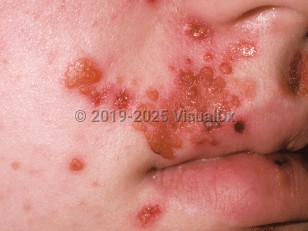Nonbullous impetigo in Infant/Neonate
Alerts and Notices
Important News & Links
Synopsis

Impetigo is the most common skin infection seen in neonates, with impetiginous infection of atopic dermatitis being the second most common. Caused by Staphylococcus aureus or group A streptococcus (Streptococcus pyogenes), it is localized to the subcorneal portion of the epidermis. In temperate climates, S aureus causes 90%-95% of the cases and S pyogenes or combination of both S aureus and S pyogenes account for 5%-10% of cases. MRSA has been reported in 1%-10% of cases.
It has been suggested but not proven that males develop impetigo more often in the diaper area and lower abdomen, while females may have it on the face more often. Constitutional symptoms and fever are minimal.
An infrequent complication of impetigo is acute poststreptococcal glomerulonephritis (APSG), which is caused by particular serotypes of S pyogenes. The risk of APSG is not reduced when antibiotic treatment is administered. Importantly, acute rheumatic fever has not been associated with impetigo.
Although MRSA infection of the skin usually presents as recurrent furunculosis or skin abscesses, MRSA has been shown to cause impetigo. Culture and sensitivities should always be performed in patients with lesions suspicious for cutaneous infection, and empiric coverage for MRSA should be instituted if clinical suspicion is high.
It has been suggested but not proven that males develop impetigo more often in the diaper area and lower abdomen, while females may have it on the face more often. Constitutional symptoms and fever are minimal.
An infrequent complication of impetigo is acute poststreptococcal glomerulonephritis (APSG), which is caused by particular serotypes of S pyogenes. The risk of APSG is not reduced when antibiotic treatment is administered. Importantly, acute rheumatic fever has not been associated with impetigo.
Although MRSA infection of the skin usually presents as recurrent furunculosis or skin abscesses, MRSA has been shown to cause impetigo. Culture and sensitivities should always be performed in patients with lesions suspicious for cutaneous infection, and empiric coverage for MRSA should be instituted if clinical suspicion is high.
Codes
ICD10CM:
L01.01 – Non-bullous impetigo
SNOMEDCT:
238374001 – Non-bullous impetigo
L01.01 – Non-bullous impetigo
SNOMEDCT:
238374001 – Non-bullous impetigo
Look For
Subscription Required
Diagnostic Pearls
Subscription Required
Differential Diagnosis & Pitfalls

To perform a comparison, select diagnoses from the classic differential
Subscription Required
Best Tests
Subscription Required
Management Pearls
Subscription Required
Therapy
Subscription Required
References
Subscription Required
Last Reviewed:02/26/2024
Last Updated:02/27/2024
Last Updated:02/27/2024
 Patient Information for Nonbullous impetigo in Infant/Neonate
Patient Information for Nonbullous impetigo in Infant/Neonate
Premium Feature
VisualDx Patient Handouts
Available in the Elite package
- Improve treatment compliance
- Reduce after-hours questions
- Increase patient engagement and satisfaction
- Written in clear, easy-to-understand language. No confusing jargon.
- Available in English and Spanish
- Print out or email directly to your patient
Upgrade Today

Nonbullous impetigo in Infant/Neonate

